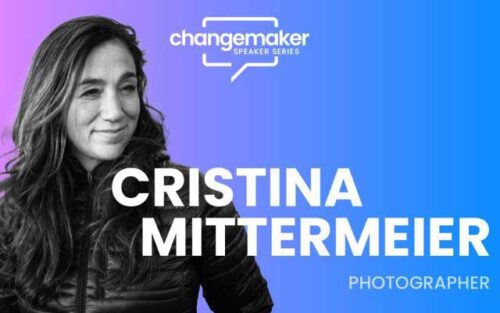
“When I grew up I wanted to become a marine biologist,” conservation photographer Cristina Mittermeier said. And for a brief moment, she was. Mittermeier graduated from the ITESM University in Mexico with a degree in biochemical engineering in Marine Sciences and began working with industrial fishing companies.
She told the story of her first time on a shrimping boat.
“For every pound of shrimp, there were 10 pounds of other fish — sea turtles, starfish, stingrays. And they were just swept dead back into the ocean,” she said. “I think that’s the moment I became an environmentalist.”
This story was one of many Mittermeier told on Feb. 18 as she kicked off the Hult Center’s Changemakers Speaker Series. Mittermeier is most known for her photography work, but as she explained, her first love was science.
She said that she wanted to be a scientist, but that science is a difficult language for most people to understand, and it’s hard to create emotion when people don’t understand what’s going on. So she picked up a camera and hasn’t looked back since.
In 2005 she founded the International League of Conservation Photographers, which aims to drive impact through ethical photography and documentary film. In 2018 she was named one of National Geographic’s Adventurers of the Year and her work has been published in countless outlets such as TIME, National Geographic and McLean’s.
While going through slides of her photos that showed sea turtles, marine iguanas and schools of fish, Mittermeier talked about working with Indigenous peoples, the amazing wildlife she’s gotten to experience, and the creation and mission of her company with husband Paul Nicklen, SeaLegacy, which they co-founded in 2005. The mission of SeaLegacy is to inspire love for the ocean, to amplify people around the world working to protect it and to catalyze hands-on diplomacy through visual storytelling.
One of SeaLegacy’s first successes was stopping oil drilling activities in Norway’s Arctic Ocean. Through photography and film as well as collaboration with local activists, the company was able to get global attention which motivated officials to halt the drilling.
Mittermeier paused from talking about SeaLegacy’s work and photos to talk about ikigai, a Japanese term that translates to “a reason to live.” She explained it’s the intersection of what you love, what you’re good at, what you can be paid for and what the world needs.
“The thing that most people miss is this fourth piece — things that the world needs. Most people think about making money and paying the mortgage, but how do you give back to society?” she asked the audience. “I think when you find that fourth piece you find a reason to get up in the morning.”